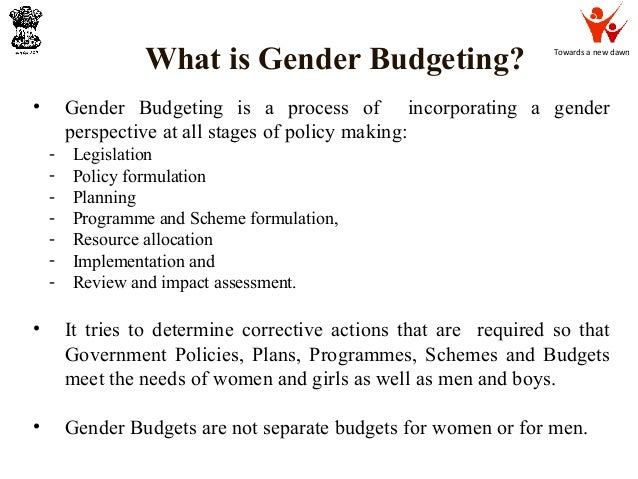Gender Budgeting
Relevance: Mains: G.S paper I: Society and social issues & G.S paper II: Governance & G.S paper III: Economy: Budget: & Sociology: Social Changes in India: (i) Visions of Social Change in India: (a) Idea of development planning and mixed economy. (b) Constitution, law and social change.Poverty, deprivation and inequalities. (c) Violence against women.
Introduction:

• Gender is an allocation primary budgeting goal of public re-orienting is a policy resources, with the advocating for an advanced decision making role for women in important issues, and securing equity in the distribution of resources between men and women.
• Gender budgeting allows the governments to promote equality through fiscal policies by taking analyses of a budget’s differing impacts on the sexes as well as setting goals or targets for equality and allocating funds to support those goals.
• Gender budgeting remedies the disadvantages and discrimination against women by incorporating them in the budgetary process and fighting marginalisation and exclusion from economic, political, and constitutional processes.
Establishing gender-specific impact:
• It is not a separate budget for women; rather it is a dissection of the government budget to establish its gender-specific impact and to translate gender commitments into budgetary commitments. Given differences in needs, Gender Budgeting is not about simply dividing government money 50-50 between men and boys on the one hand, and women and girls on the other.
• A simple 50-50 division may look equal, but it is often not equitable, or fair, because the needs of women and men and girls and boys may be different.
• Instead, Gender Budgeting looks at every part of the government budget to assess how it will address the different needs of women and men, girls and boys, and different groups of women and men, girls and boys. For example, in the area of health, male and female people will have similar needs in respect to influenza and malaria. But women will have greater needs than men in terms of reproductive health.
Gender and Sex:
• Before discussing Gender Budgeting, we need to understand what gender is, and the difference between gender and sex. Gender is the culturally and socially constructed roles, responsibilities, privileges, relations and expectations of women and men, boys and girls.
• Because these are socially constructed, they can change over time and differ from one place to another. Sex is the biological make-up of male and female people. It is what we are born with, and does not change over time, nor differs from place to place.
• There is a need to think about both gender and sex when making policies and allocating budgets to implement the policies. In respect of sex, it should be ensured that policies and programs are available and adequately financed to address the different biological needs of women and men, including childbearing for women.
• In respect of gender, we need to have a vision of the type of roles, responsibilities, and relationship that we want to see in the country for women and men, girls and boys, and design, fund and implement policies and programs to move towards this goal.
Need for Gender Budgeting:
The Constitution of India has mandated equality for every citizen of the country as a fundamental right. Gender Budgeting serves varied purposes. These include, among others:
• Identifying the needs of women and reprioritising expenditure to meet these needs;
• To supporting gender mainstreaming in macroeconomics;
• To strengthening civil society participation in economic policymaking;
• To enhancing the linkages between economic and social policy outcomes;
• To tracking public expenditure against gender and development policy commitments; and
• To contributing to the attainment of the Sustainable Development Goals (SDGs).
Scope for Gender Budgeting:
Generally, budgeting involves four components:
• The budgetary allocation of resources to various heads,
• The actual Government outlays on various heads,
• An accounting of how resources are utilized for a particular purpose and
• An evaluation of the effectiveness of the resources utilised in delivering the intended results.
Gender budgeting involves looking at all the four components from the point of view of women as beneficiaries.
Examples of possible activities for Gender Budgeting at the different stages of budgeting process are described below:
At the budget preparation stage:
• Ensure financial appropriations made in budgets enable the implementation of programs, schemes and activities in a way that will match the needs;
• Assess likely impact of new revenue-raising methods on different groups, compared with their ability to pay;
• Compare Budget Estimates (BE) for the current year with Revised Estimates (RE) and Actual Expenditure (AE) of the previous year and ensure corrective steps are taken to ensure proper and full utilisation of the budgets of current year.
When the budget is tabled:
• Analyse sector-wise or ministry/department wise trends and shares of allocations and expenditure as an indicator of government’s priorities;
• Analyse the revenue side as in what are the sources of revenue, subsidies, etc., and how will they impact men and women.
At the budget implementation stage:
• Is the budget being spent in the way it was intended and to the full extent? What are the delivery costs? Who is receiving subsidies? Is the budget being spent for the purpose and the people for which/whom it was intended?
• Gender Budgeting can also be done and used by people outside the government such as in women’s organisations, non-governmental organisations, academia, the donor community, the legislature, as well as by ordinary citizens.
• For those outside government, Gender Budgeting can encourage transparency, accountability and participation, and facilitate better advocacy. For those both inside and outside government, Gender Budgeting work provides information that allows for better decisionmaking on how policies and priorities should be revised and the accompanying resources needed to achieve the goal of gender equality.
Gender Budgeting in India:
• India’s gender budgeting efforts stand out globally because they have not only influenced expenditure but also revenue policies at national and state government levels. The goal of Gender Budgeting in India is to ensure greater efficiency and gender equity in fiscal policy.
• Gender budgeting has been integrated into many aspects of public finance, which includes informing tax reforms, revising budget classification procedures to integrate gender in shaping intergovernmental fiscal transfers, fiscal decentralisation efforts, and local budgeting, and assessing the effectiveness of public expenditure through the development of benefit incidence analysis.
Impact of Gender Budgeting:
• There is a need to evaluate the impact of Gender Responsive Budgeting (GRB) that was adopted by India in 2005 following which at least 57 government ministries/departments set up Gender Budgeting Cells.
• An analysis conducted by National Institute of Public Finance and Policy reveals that GRB has not translated effectively into policies that impact women despite being a promising fiscal innovation to begin with.
• Though some studies have shown encouraging results. One study shows that states with Gender Budgeting showed significantly greater reduction in spousal violence between 2005–06 and 2015– 16 than those without it, using data from National Family Health Survey (NFHS) waves 3 (2005–06) and 4 (2015–16). Where Gender Budgeting states demonstrated a 7 percent decline in spousal violence from 2005–06 to 2015–16, non-gender budgeting states demonstrated only a one percent decline.
Whether Gender Budgeting has a positive impact on gender equality or not?
• As per latest research conducted on data available from the Asia Pacific region, the answer is in affirmative. The scores on GDI (Gender Development Index) and GII (Gender Inequality Index) for each country were used as measures of gender equality or inequality.
The results show that GII is significantly determinedby gender budgeting initiatives, public spending on health and female labour force participation.
• The estimates showed that a 1 per cent increase in public health spending in Asia Pacific can reduce GII by 0.0045 percentage points, while similar rise in female labour force participation can reduce GII by 0.0041 percentage points.
Conclusion:
• India has integrated gender budget within the Expenditure Budget and also given instructions to integrate it into the Outcome Budget. However, the capacity of sectoral gender budgeting cells to carry
out specific analysis of gender-related needs and advocate for policies and programs remains a challenge. Way forward is to build capacity at centre and state level for better implementation of gender
budget and improvement in fiscal marksmanship.
• Quantum of budgetary allocation for women focused schemes vis-a-vis total budgetary allocation should be increased and at the same time implementation of the policies should be so monitored that the allocated budget is spent strictly under the head it was allocated for. The revenue side of the gender budget should also be strengthened to empower women through innovative taxation policies.
For more such notes, Articles, News & Views Join our Telegram Channel.
Click the link below to see the details about the UPSC –Civils courses offered by Triumph IAS. https://triumphias.com/pages-all-courses.php

